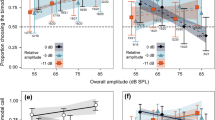Abstract
Males of the planthopper Ribautodelphax imitanswere exposed to playbacks of either conspecific or heterospecific (R. imitantoides)female calls during their development from egg to adult, and thereafter these, as well as naive males,were offered a two- way choice between these calls. Males of all treatments approached the conspecific call significantly more often. However, males primed by the conspecific call chose the heterospecific call almost four times less often than did males primed by heterospecific calls or naive males, thus showing that the preference for conspecific calls can be partly “learned.” Males primed by heterospecific calls performed very similarly to completely naive males, suggesting that the signal recognition mechanism is much less sensitive to heterospecific calls than to conspecific calls. Males with experience of the conspecific female call tended to take more time to reach the call source in the trials than both other types of males. The evolutionary implications of these findings are discussed.
Similar content being viewed by others
References
Bell, W. J. (1990). Searching behavior patterns in insects.Annu. Rev. Entomol. 35: 447–467.
Claridge, M. F. (1985). Acoustic behaviour of leafhoppers and planthoppers. In Nault, L. R., and Rodriguez, L. R. (eds.),The Leafhoppers and Planthoppers, John Wiley and Sons, New York, pp. 103–125.
Claridge, M. F., Den Hollander, J., and Morgan, J. C. (1985a). Variation in courtship signals and hybridization between geographically definable populations of the rice Brown planthopper,Nilaparvata lugens (Stål).Biol. J. Linn. Soc. 24: 35–49.
Claridge, M. F., Den Hollander, J., and Morgan, J. C. (1985b). The status of weed-associated populations of the brown planthopper,Nilaparvata lugens (Stål)—host race or biological species?Zool. J. Linn. Soc. 84: 77–90.
De Winter, A. J. (1992). The genetic basis and evolution of acoustic mate recognition signals in aRibautodelphax planthopper (Homoptera, Delphacidae). 1. The female call.J. Evol. Biol. 5: 249–265.
De Winter, A. J., and Rollenhagen, T. (1990). The importance of male and female acoustic behaviour for sexual isolation inRibautodelphax planthoppers (Homoptera, Delphacidae).Biol. J. Linn. Soc. 40: 191–206.
Den Bieman, C. F. M. (1986). Acoustic differentiation and variation in planthoppers of the genusRibautodelphax (Homoptera, Delphacidae).Neth. J. Zool. 36: 461–480.
Den Bieman, C. F. M. (1987). Host plant relations in the planthopper genusRibautodelphax (Homoptera, Delphacidae).Ecol. Ent. 12: 163–172.
Den Biemen, C. F. M. (1988). Hybridization studies in the planthopper genusRibautodelphax (Homoptera, Delphacidae).Genetica 76: 15–26.
Heady, S. E., and Denno, R. F. (1991). Reproductive isolation inProkelisia planthoppers (Homoptera: Delphacidae): Acoustic differentiation and hybridization failure.J. Insect Behav. 4: 367–390.
McGuire, T. R. (1984). Learning in three species of Diptera: The blow flyPhormia regina, the fruit flyDrosophila melanogaster, and the house flyMusca domestica.Behav. Genet. 14: 479–526.
O'Hara, E., Pruzan, A., and Ehrman, L. (1976). Ethological isolation and mating experience inDrosophila paulistorum.Proc. Natl. Acad. Sci. USA 73: 975–976.
Papaj, D. R., and Prokopy, R. J. (1989). Ecological and evolutionary aspects of learning in phytophagous insects.Annu. Rev. Entomol. 34: 315–350.
Paterson, H. E. H. (1978). More evidence against speciation by reinforcement.S. Afr. J. Sci. 74: 369–371.
Paterson, H. E. H. (1985). The recognition concept of species. In Vrba, E. S. (ed.),Species and Speciation, Transvaal Museum Monograph 4, Pretoria, pp. 21–29.
Pruzan, A., Ehrman, L., Perelle, I., and Probber, J. (1979). Sexual selection,Drosophila age and experience.Experientia 35: 1023–1025
Sene, F. M. (1977). Effect of social isolation on behavior ofD. ilvestris from HawaiiProc. Haw. Entomol. Soc. 22: 469–474
Shuvalov, V. F., Rüting, T., and Popov, A. V. (1990). The influence of auditory and visual experience on phonotactic behavior of the cricket,Gryllus bimaculatus.J. Insect Behav. 3: 289–302
Templeton, A. R. (1980). The theory of speciationvia the founder principle.Genetics 94: 1011–1038
Author information
Authors and Affiliations
Rights and permissions
About this article
Cite this article
De Winter, A.J., Rollenhagen, T. Differences in preference for species-specific female calls between acoustically experienced and acoustically naive maleRibautodelphax planthoppers (Homoptera: Delphacidae). J Insect Behav 6, 411–419 (1993). https://doi.org/10.1007/BF01048120
Accepted:
Issue Date:
DOI: https://doi.org/10.1007/BF01048120




